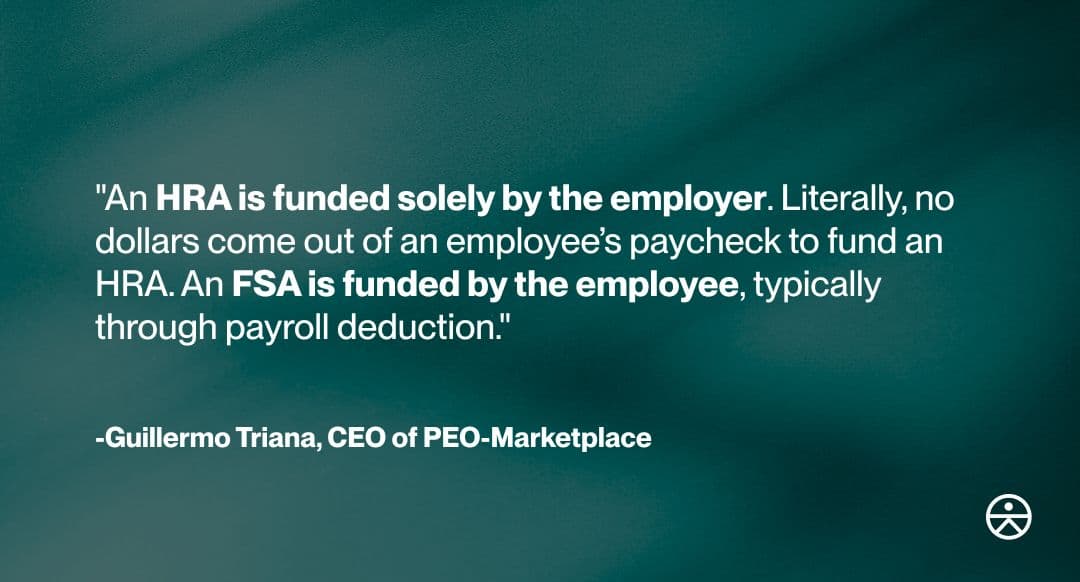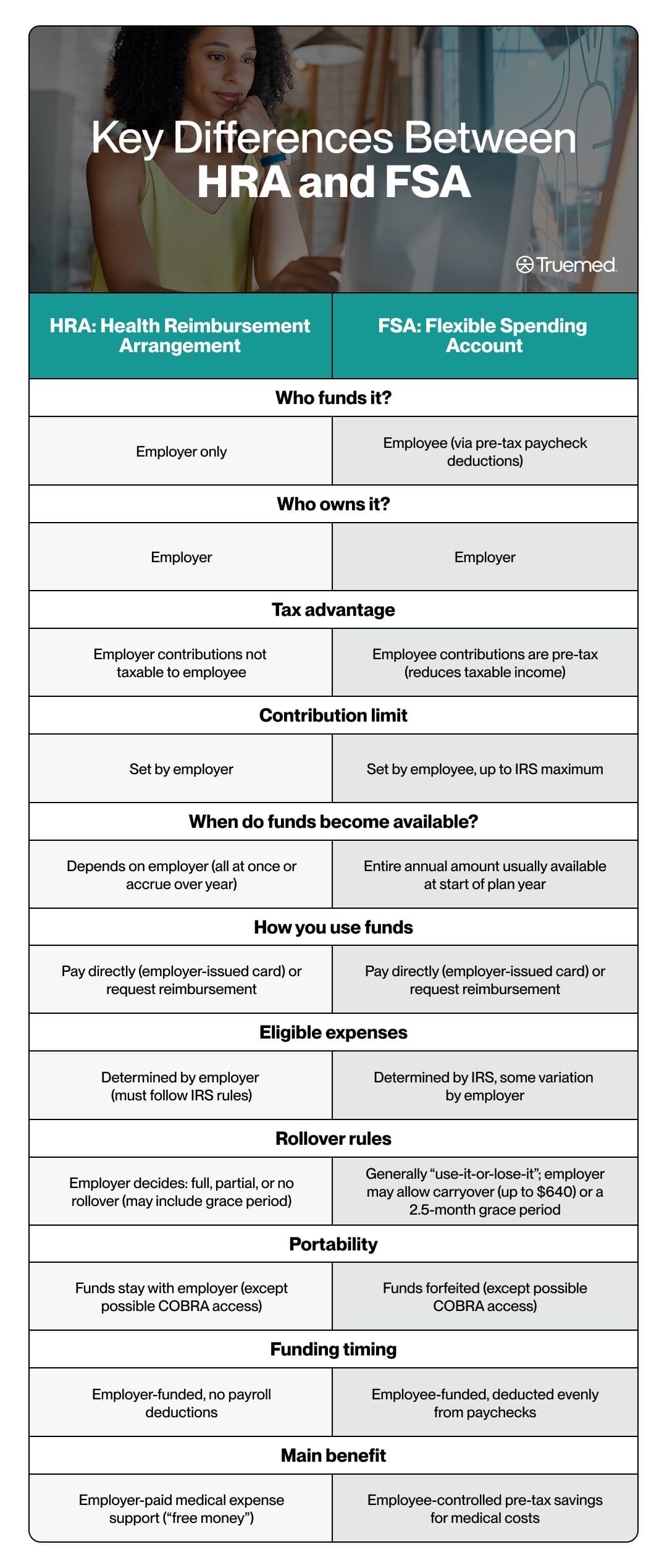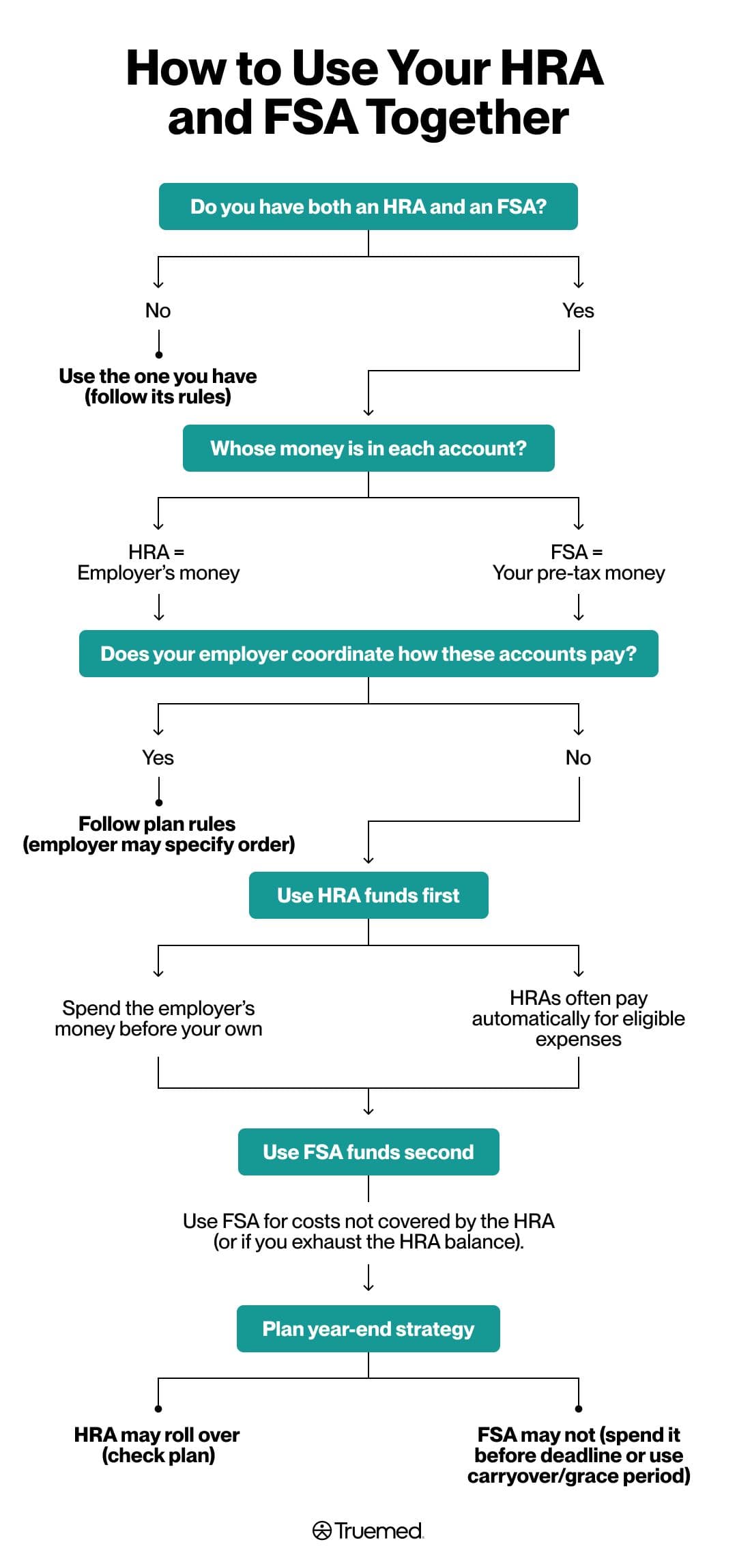HRA vs. FSA: What’s the Difference?
Author:Jennifer Chesak
Reviewed By:Katherine Janosz, MD
Published:
November 17, 2025

HRA vs. FSA: What's the Difference?
A health reimbursement account (HRA) and a flexible spending account (FSA) are both handy employer-sponsored benefits that help you pay for qualifying medical expenses. The key difference lies in who funds these accounts, your employer (HRA) or you with your pre-tax dollars (FSA).
When considering various employee benefit options or how to manage your healthcare spending, life can get a bit full of alphabet soup, especially with similar products, such as an HRA and FSA.
For example, at your job, you might have the option of both a health reimbursement account (HRA) and a flexible spending account (FSA) as employee benefits. If these two items went head-to-head—HRA vs. FSA—in the boxing ring, which one would take the win? Or could they both give you a big win? Indeed, these two can play well together if your employer offers them.
“An HRA is funded solely by the employer. Literally, no dollars come out of an employee’s paycheck to fund an HRA,” says Guillermo Triana, the founder, principal consultant, and CEO of PEO-Marketplace, an HR consultancy business. “An FSA is funded by the employee, typically through payroll deduction.”

So there you have it: the nutshell answer. In this article, we’ll explore, in depth, the difference between an HRA and FSA, how they might work together, and more. So let’s go for a swim in the alphabet soup.
What is an HRA?
An HRA is an employee benefit offered by various companies and businesses to eligible employees. The account helps you pay for qualifying medical expenses. You do not pay taxes on the funds.
Who funds an HRA?
Your employer funds the account, meaning that you do not use any portion of your paycheck or overall salary to fund it.
“That’s essentially free money for your health expenses,” says David Torosyan, a human resources and payroll manager at J&Y Law.
Your employer determines how much money they place into the account. Why would your employer give you “free money” though? Your employer gets a tax deduction on the amount they place into your HRA.
How does an HRA work?
You can pay for qualifying medical expenses in one of two ways, determined by your employer.
- Your employer might issue you a debit card so that you can pay for qualifying medical expenses directly from your HRA account, though you will likely be required to submit receipts and other documentation to show that you used the funds appropriately.
- Or your employer may require you to pay for qualifying medical expenses from your own accounts, such as checking, savings, or a credit card. Then you submit your receipts and any necessary documentation to receive reimbursement from your HRA.
When are HRA funds available?
Your employer determines the rules of your HRA. Depending on your plan’s rules, all the funds might be available on the first of the year, or they may accrue throughout.
They determine (to a certain extent) which medical expenses qualify, following laws for these accounts. They also determine whether all, a portion, or none of the funds remaining in your HRA at the end of the year will roll over for use in the following year. In some cases, rollover funds might only be accessible for a grace period.
Can you take an HRA with you?
If you quit or lose your job, the funds remain with your employer; you cannot take them with you. However, if you qualify for and elect to temporarily maintain your health insurance coverage under the Consolidated Omnibus Budget Reconciliation Act (COBRA), you might still retain access to your HRA.
What is an FSA?
An FSA is also an employee benefit offered at various companies and businesses to eligible employees. The account helps you pay for qualifying medical expenses. You determine how much money to contribute to the account, up to a maximum the IRS designates for the year.
Who funds an FSA?
During your health benefits open-enrollment period (typically from November 1 to January 15, but dates can vary by employer) you designate the entire amount you want in your FSA for the year to come. Your employer will place the full amount in your FSA by the start of the year. Then payroll deducts a portion of that amount from your paycheck to reimburse the company.
The money comes from your paycheck’s pre-tax dollars. With each paycheck, your employer withholds the amount you must pay in taxes. The amount you designate to fund your FSA gets deducted from your gross paycheck (before withholdings). By designating pre-tax dollars to go into your FSA, you reduce your taxable income.
How does an FSA work?
You can use the funds to pay for qualifying medical expenses in one of two ways, designated by your employer.
- Your employer may issue you a debit card so that you can pay for qualifying medical expenses directly from your FSA account, though you should keep your receipts and other documentation to show that you’ve used the funds appropriately.
- Or your employer may require you to pay for qualifying medical expenses from your usual accounts, such as checking, savings, or a credit card. Then you submit your receipts and any necessary documentation to receive reimbursement from your FSA.
When are FSA funds available?
Your employer determines some of the rules of your FSA, following federal laws. Generally, FSA funds are “use-it-or-lose-it,” meaning you forfeit any money remaining in the account at the end of the year.
But the plan can either provide a carryover or a grace period.
- Grace period: You can still use the remaining money within 2.5 months of the new year.
- Carryover: You can roll over up to the IRS-allowed carryover limit (which is adjusted annually) into the new year, to be used at any time.
Can you take an FSA with you?
If you quit or lose your job, you forfeit your FSA. However, if you qualify for and elect to temporarily maintain your health insurance coverage under COBRA, you might still retain access to your FSA.
HRA vs FSA: Key Differences at a Glance

Eligible Expenses: Where They Overlap and Differ
You might be wondering what medical expenses qualify with an HRA or FSA. The IRS provides guidance about eligible medical expenses under its Publication 502. The list includes an array of expenses from acupuncture and alcoholism treatment to vasectomy and weight-loss programs. Both an HRA and FSA must follow these rules.
However, a key difference between an HRA and FSA is that your employer can narrow (but not expand) what’s eligible with an HRA. For example, they might narrow the list to include just your deductibles and copays.
With an FSA, items listed on Publication 502 generally qualify. Your employer has some limited discretion to narrow what’s eligible, but they cannot expand it.
Additionally, some specific HRA types, like ICHRAs, can include your health insurance coverage premiums as qualifying expenses. Check with your employer about this. With FSAs, however, insurance premiums are not included.
Finally, with HRAs and FSAs, a letter of medical necessity (LMN) may help eligible employees access additional medical expenses that are not automatically eligible but can with an LMN. (See the section below on LMNs.)
LMN (Letter of Medical Necessity): When It Matters
An LMN is a formal document from a licensed healthcare provider that explains why a certain product, treatment, or service is necessary to treat, mitigate, or prevent a medical condition.
Certain health products and services may be HRA or FSA eligible for qualified customers with an LMN (which can be issued by an independent clinician through Truemed) when the item is used to address a specific medical condition. Such purchases can include, in some cases, gym memberships, personal home fitness equipment, or massage therapy.
Shane Lucado, Esq., the founder and CEO of Interqubit, says an LMN “is a gateway for consideration.” He adds, “Without it, those claims would be rejected according to IRS regulations.”
How It Works with HRA or an FSA at Truemed
Truemed specializes in helping you maximize your HRA, FSA, and other health-related benefits.
- First, you can check whether a product or service is normally considered a qualifying medical expense or whether you might need an LMN.
- If an LMN is appropriate, an independent licensed practitioner (via Truemed’s clinical partner) will review your medical history, and if you qualify, they’ll issue the LMN. Truemed itself does not make eligibility determinations.
- You can then pay for qualifying products and services with your HRA’s or FSA’s debit card or get reimbursed for expenses after submitting your LMN and receipts.
- Truemed also offers support in the event you get a denial of reimbursement and need to provide substantiation documentation.
Which Is Better for You?
“In an apples‑to‑apples comparison, there’s no such thing as ‘better,’” says Triana.
Lucado agrees. “Frankly, it’s the stuff of myth to think one is superior,” he says.
If your employer offers both and you are eligible for both, you can opt in to an HRA and an FSA.
But here are a few examples where you might choose one over the other if you’re only opting into one of these benefits.
Keep in mind:
- An HRA is money your employer is essentially giving you—that goes beyond your earned paycheck—to pay for qualifying medical expenses. With an FSA, the money comes from your paycheck, but before taxes are withheld. So an FSA helps reduce your taxable income. HRA dollars do not get taxed, but they don’t reduce your taxable income.
- Your employer does have the power to dramatically narrow what’s considered a qualifying medical expense under an HRA plan, whereas with an FSA, they have limited ability to narrow what’s eligible.

Compliance & Pitfalls to Avoid
If you have an HRA or FSA or both, you want to ensure you follow all the rules regarding using it for eligible expenses and more. Here are a few things to keep in mind:
- Don’t claim the same expense for multiple accounts, a pitfall called “double-dipping.” For example, you can’t submit for reimbursement from both an HRA and an FSA, or from one of your benefit accounts and your spouse’s.
- Keep all receipts, explanation of benefits (EOB), and LMNs.
- Be mindful of deadlines for open enrollment, plan-year’s end, grace periods, and carryovers.
- Remember that HRAs and FSAs do not move with you if you switch jobs, so you will forfeit the money if you don’t use it before leaving your current employer. However, if you lose your job and elect to use COBRA, a law that allows qualified individuals to continue their employer-sponsored health coverage for a limited period, you may be able to continue accessing your HRA or FSA funds.
Truemed is for qualified customers. HRA/FSA tax savings vary. Learn more at http://truemed.com/disclosures.
HRAs and FSAs:: These benefits can save you money on healthcare costs, but your employer funds an HRA, while you fund an FSA with your pre-tax dollars.
Control:: Your employer controls more of the HRA rules regarding what medical expenses qualify, while FSAs typically align with IRS lists, potentially giving you a bit more control.
Combination:: You can opt in to both an HRA and FSA if your employer offers these benefits and you are eligible.
Truemed: Truemed can help you maximize your HRA and FSA benefits by streamlining the process by which qualified individuals can spend on eligible medical intervention.
Editorial Standards
At Truemed, we believe better health starts with trusted information. Our mission is to empower readers with accurate and accessible content grounded in peer-reviewed research, expert insight, and clinical guidance to make smarter health decisions. Every article is written or reviewed by qualified professionals and updated regularly to reflect the latest evidence. For more details on our rigorous editorial process, see here.


